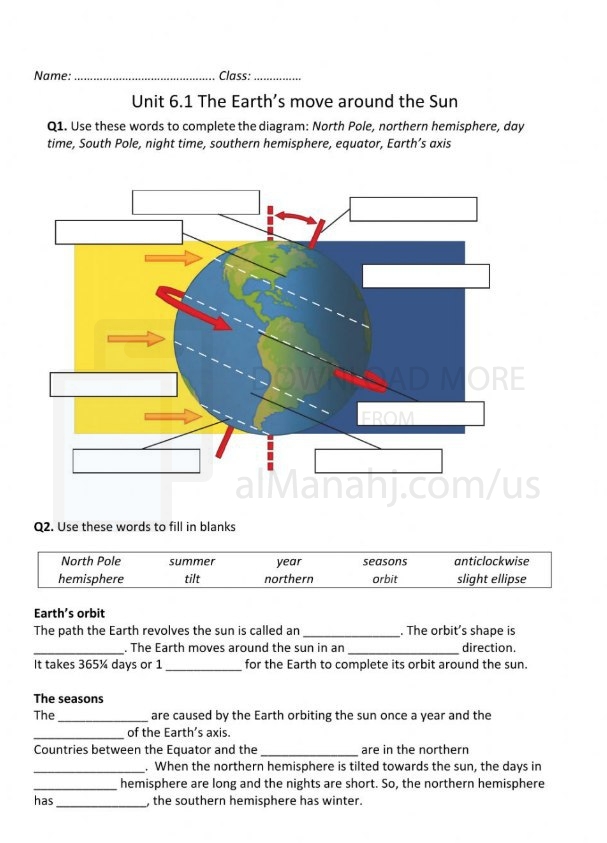| You are here: Almanahj Website ⇒ American curriculum ⇒ 4th Grade ⇒ Geology ⇒ Term 1 | ||
|---|---|---|
Worksheet about The Earth moves around the Sun | ||
|---|---|---|
| Subject: Geology | ||
| 4th Grade | ||
| Term 1 | ||
| Year: 2023/2024 | ||
| Size: 263.5KB | ||
| Number of clicks: 183 | ||
| Publish date:November 29, 2023 | ||
| Added by: Eman | ||
| Last download date: 2024-09-08 05:31:59 | By: theodor mscurly | |
| File info: That's correct! The Earth moves around the Sun in a path called an orbit. This motion is known as revolution. Here are some key points about the Earth's revolution around the Sun: 1. Orbit: The Earth follows an elliptical orbit around the Sun, with the Sun located at one of the two foci of the ellipse. The shape of the Earth's orbit is close to being circular, so the deviation from a perfect circle is minimal. 2. Duration of Revolution: The time it takes for the Earth to complete one revolution around the Sun is approximately 365.25 days. This period is the basis for our calendar year. To account for the extra fraction of a day, we have a leap year every four years, except for years divisible by 100 but not by 400 (e.g., the year 2000 was a leap year, but 1900 was not). 3. Speed of Revolution: The average speed of the Earth in its orbit is about 30 kilometers per second (67,000 miles per hour). This speed varies slightly throughout the year due to the elliptical shape of the orbit. The Earth is closest to the Sun during its orbit, called perihelion, around early January, and farthest from the Sun, called aphelion, around early July. 4. Tilted Axis: The Earth's axis is tilted with respect to its orbit around the Sun. This tilt is approximately 23.5 degrees. It is this tilt that causes the changing seasons on Earth as different parts of the planet receive varying amounts of sunlight throughout the year. 5. Effects on Seasons: As the Earth revolves around the Sun, the tilt of its axis causes the angle and intensity of sunlight to change. When a hemisphere is tilted towards the Sun, it receives more direct sunlight and experiences summer. When tilted away from the Sun, the hemisphere receives less direct sunlight and experiences winter. The equinoxes, around March 20th and September 22nd, mark the times when the axis is not tilted towards or away from the Sun, resulting in roughly equal day and night lengths. Understanding the Earth's revolution around the Sun is fundamental to our understanding of seasons, climate patterns, and the measurement of time. It is worth noting that while the Earth revolves around the Sun, it also rotates on its axis, causing day and night cycles. | ||
| Downloading link Worksheet about The Earth moves around the Sun |
|---|
|
1701255723.pdf
The file is being prepared for download
|
| File images |
|---|
 |